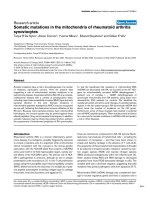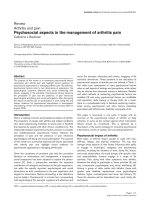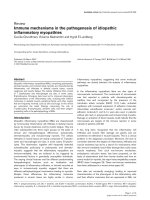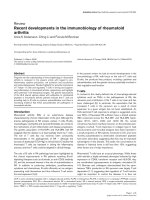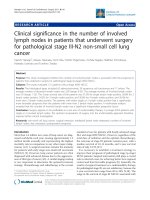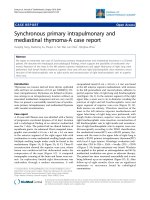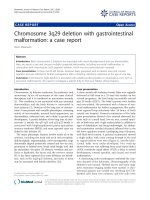Báo cáo y học: " Severe hydrops in the infant of a Rhesus D-positive mother due to anti-c antibodies diagnosed antenatally: a case report" pot
Bạn đang xem bản rút gọn của tài liệu. Xem và tải ngay bản đầy đủ của tài liệu tại đây (278.07 KB, 4 trang )
CAS E RE P O R T Open Access
Severe hydrops in the infant of a Rhesus
D-positive mother due to anti-c antibodies
diagnosed antenatally: a case report
Shilpa Singla
*
, Sunesh Kumar, Kallol Kumar Roy, Jai Bhagwan Sharma, Garima Kachhawa
Abstract
Introduction: Rhesus haemolytic disease of the newborn is a prototype of maternal isoimmunisation and fetal
haemolytic disease. There are other rare blood group antigens capable of causing alloimmunisation and
haemolytic disease such as c, C, E, Kell and Duffy. In India, after the confirmation of a newborn’s blood group,
antibodies are screened only if the mother is Rehsus D-negative negative and the father is Rhesus D-positive.
Hydrops in Rhesus positive women are investigated along the lines of non-immune hydrops.
Case presentation: We report the case of a patient from India where irregular antibodies were requested for an
O-positive 26-year-old mother in order to investigate fetal hydrops. Anti-c antibody was revealed and the fetus was
treated successfully with compatible O negative and c negative intrauterine blood transfusions. The baby was
treated postnatally with double volume exchange transfusion with the same compatible blood, and was
discharged 30 days after birth.
Conclusion: We highlight the importance of conducting irregular antibody screenin g for women with significant
obstetric history and fetal hydrops. This could assist in diagnosing and successfully treating the fetus with
appropriate antigen negative cross-matched compatible blood. We note, however, that anti-c immunoglobulin is
not yet readily available.
Introduction
Haemolytic disease of the newborn is a well-recognised
entity because of the isoimmunisation of Rhesus D-nega-
tive mother in an Rh-positive fetus. Severe degrees of
fetal hemo lysis result in fetal hydrops [1]. Although anti-
Rh(D) was once the major etiology of haemolytic disease
of the fetus and newborn (HDFN), the widespread adop-
tion of antenatal and postnatal Rhesus immunoglobulin
has resulted i n a marked decrease in the prevalence o f
alloimmunisation due to the RhD antigen present during
pregnancy. Maternal alloimmunisation to other red cell
antigens remains the cause of fetal disease since no pro-
phylactic immunoglobulins are available to prevent the
formation of these antibodies [2].
Mild to severe cases of fetal haemolytic disease have
beenreportedwhenanti-c,C,e,E,orKell,Kidd,Duffy,
MNS, Lutheran, Diego, Xg, P antibodies, as well as other
private and public blood group systems found in the sera
of mothers [3]. It is recommended that routine red cell
antibody screening be done at the first appointment in
pregnant mothers and, if no antibodies are detected, once
more in the third trimester between 28 and 36 weeks [4].
The guidelines state that further testing is unnecessary,
since immunisation during late pregnancy is unlikely to
result in an antibody concentration that would be suffi-
cient to cause severe haemolytic disease of the neonate [4].
However, in the majority of transfusion and antenatal
care centres in India and other developing countries,
routine antenatal antibody screening is done only for Rh
(D)-negative mothers to s creen for Anti-D antibodies.
Hence, there may be a serious delay i n diagnosing
HDFN due to the rarity of antigens [5]. The first case of
haem olytic disease of the newborn due to anti-c antibo-
dies in India was published in a retrospective diagnosis
made in 2007. Fetal affection was noted to be of a
milder variety, where the baby was managed only with
intravenous immunoglobulin and phototherapy [5].
* Correspondence:
Department of Obstetrics and Gynecology, All India Institute of Medical
Sciences, New Delhi, 110029, India
Singla et al. Journal of Medical Case Reports 2010, 4:57
/>JOURNAL OF MEDICAL
CASE REPORTS
© 2010 Singla et al; licensee BioMed Central Ltd. This is an Open Access article distributed under the terms of the Creative Commons
Attribution Lice nse (http://c reativecommons.org/licenses/by/2.0), which permits unrestricted use, distribution, and reproduction in
any medium, provided the original work is properly cited.
Here we report the first known case of antenatally
diagnosed a nti-c antibodies that resulted in severe fetal
hydrops, thus requiring multiple in utero and ex utero
transfusions.
Case presentation
A 26-year-old Indian woman was admitted to our gas-
troenterolo gy unit with extrahepatic portal vein obstruc-
tion with features of massive malena at 29 weeks of
gestation. She had a previous pregnancy that resulted in
asingleoffspring.Shewasreferredforanantenatal
check-up to our obstetric unit, where after clinical
examination, an ultrasonography was performed which
rev ealed gross fetal hydrops. She was transferred to our
obstetric unit for further evaluation and management.
Her prenatal course was complicated by recurrent epi-
sodes o f hematemesis and malena for 10 years prior to
admission and she was previously diagnosed with eso-
phageal varices. She had a history of multiple blood
transfusions and sclerotherapy sessions. Her first preg-
nancy was 2 years prior to admission, in which she had
regular supervised antenatal checkups on her first and
second trimesters with a normal anomaly scan. Her
pregnancy was complicated by gestational diabetes mel-
litus that was controlled thr ough diet. She had episodes
of recurrent malena in this pregnancy. Her t hird trime-
ster was unsupervised at home and she was admitted to
a local private practitioner at the onset of her labour.
She unde rwent caesarean section for meconium-stained
liquor. She delivered a grossly normal male baby with
jaundice at birth. Details pertaining to the baby are not
available, but the baby had receive d a blood transfusion
on the third day of life and died on the seventh day.
Her present pregnancy was a spontaneous conception.
Her first and second trimester antenatal checkups were
with a pri vate practitioner in her hometown. She pre-
sented in the gastroenterology department of our insti-
tute at 29 weeks of g estation with massive malena and
anemia. Upper gastrointestinal (GI) endoscopy revealed
the presence of grade II esophageal varices for which
sclerotherapy was done. She was given three units of
packed red blood cell s to raise her haemoglobin from 6
gm% to 10 gm%. Upon obstetric referral, ultrasonogra-
phy at 30 weeks and 5 days revealed severe fetal
hydrops. Doppler studies were suggestive of fetal ane-
mia. She was given corticosteroids for fetal lung matur-
ity. At 31 weeks, cordocentesis was done and
intravas cular intra uterine fetal transfusion with O-nega-
tive cross-matched blood was given. Since she was Rhe-
sus (D) O type positive, non-immune hydrops was
suspected. Fetal blood was thus sent for bloo d grouping,
haemoglobin, haematocrit, TORCH serology, parvovirus
B19 serology, haemoglobin electrophoresis, G6PD
enzyme assay and karyotype.
The results of fetal echocardiography were normal.
Fetal blood g roup was A-po sitive and was negative in
workup for non-immune hydrops. Maternal serum
indirect Coomb’s test was positive, thus leading to a sus-
picion of the presence of non-anti-D antibodies. A spe-
cial request was sent to the blood bank to screen for
uncommon rare blood groups and non-D antibodies.
Anti-c was detected in maternal serum in 1:4 dilutions.
Maternal blood was resent to the blood bank to estab-
lish exact Rhesus haplotype, which was determined to
be R1R1 (CDe/CDe). The fetus was monitored with bi-
weekly biophysical profiling and a second intrauterine
transfusion was given one week later with compatible
O-negativeandc-negativecross-matchedblood.At32
weeks and 5 days, an emergency caesarean section was
done due to poor biophysical profile.
A grossly hydropic female baby with a birth weight of
1.6 kg was born with massive ascites, hepatosplenomegaly,
pallor and hypotonia. At birth, 150 ml of ascitic tap was
done and the baby was transferred to the nursery on bag
and tube ventilation. Her cord blood hematocrit was 15
and total serum bilirubin was 6.5 mg/dl. A partial
exchange transfusion followed by double volume exchange
transfusion with O-positive, c-negative blood was per-
formed. Intravenous immunoglobulin in doses of 1 gram/
kg was administered after the exchange. The baby required
intense phototherapy for 4 days. By the second week, she
developed conjugated hyperbilirubinemia due to inspis-
sated bile syndrome, which resolved on its own. The baby
was then managed conservatively and was discharged in
stable condition on the 30th day of her life.
The fetal rhesus haplotype was established finally as
cDe/cDe. The source of maternal isoimmunisation may
be either fetomaternal haemorrhage in the mother s
current or previous pregnancy or from multiple blood
transfusions.
Discussion
Fetal hydrops may be c lassified as either immune or
non-immune. Non-immune hydrops result from reasons
other than antigen to antibody incompatibility. Immune
hydrops results from maternal antibodies that are cap-
able of crossing the placenta to r eact with fetal antigen,
thus causing a reaction that manifests as fetal haemoly-
sis. In the largest retrospective review on the etiology of
hydrops [ 6] involving 598 patients, the cause of hydrops
was established unclearly in 26.3% of cases, isoimmuni-
sation in 4.5% of cases, and non-immune etiology in
69.2% of cases. When isoimmunisation is identified as
the cause, Rhesus antigens were responsible for 4.2% of
cases. There w ere only two cases due to non-Rh anti-
gens, one each due to Kell and to Duffy [6].
Outof49knownRhesusantigens,only5(c,C,D,e,
E) are well known. There is no d antigen. Besides this,
Singla et al. Journal of Medical Case Reports 2010, 4:57
/>Page 2 of 4
there are other rare blood group systems like Kell, Duffy
(Fya and FYb), Kidd (JKa and JKb), and the M and N
system [7].
CDe is the most common haplotype in Caucasians
(42%), Native Americans (44%) and Asians (70%) [8]. In
various retrospective studies, haemolytic disease of the
newborn has been reported due to Anti-c a ntibodies
[9-11]. The frequency of D and Non-D antigens differ in
different populat ions with respect t o their ethnic origin
[12-14].
It is important to check that patients with anti-c anti-
bodies do not have any additional antibodies for although
these might not compound a ny HDFN, t hey would cer-
tainly delay the provision of compatible blood for trans-
fusion [9]. Bowell et al. (1986) observed a strong co-
association of anti-c with anti-E in 41% of their subject
population [9]. Perinatal mortality due to anti-c alone is
usually much lower than that of Anti-D (1 in 250,000
versus 1 in 25,600 births, respectively) [15].
However, the comb ination of anti-c and anti-E anti-
gens can cause the occurrence of severe fetal and neo-
natal haemolytic disease [3].
The management of anti-c isoimmunisation or isoimmu-
nisation with any other irregular red blood cell antibody is
similar to the management of anti-D isoimmunised preg-
nancy, with a specification that blood used for fetal and/or
neonatal transfusion should be negative for its respective
antibody. Critical titre needs to be standardized with
respect to individual laboratories. In a series by Hackney et
al.[11],acriticaltitreof1:32 without supplementation
with ultrasound and a critical titre of 1:16 supplemented
with ultrasonographic features of hydrops were considered
significant. In our patient, a dilution titre of 1:4 was asso-
ciated with fetal hydrops and no other irregular antibody
or any other cause of non-immune hydrops could be
attributed. There was a significant improvement in fetal
and neonatal anemia following transfusion with c-negative
blood, attributing it as the sole cause of fetal haemolysis
and hydrops. However, fetal and/or neonatal direct
Coomb s test (DCT) positivity does not necessarily corre-
late with a severe haemolytic disease. DCT may be nega-
tive in anti-c isoimmunisation as this antibody is often
present in small titres [9]. Serologic evaluation of maternal
ant ibod ies thus remains the cornerstone of management
as approximately only 50% of antigen positive fetuses
require a more invasive testing [11].
Our experience in the management of our patient was
similar to that of other authors [3,5,11]. However,
instead of t he traditional method of spectrophotometric
evaluation of amniotic fluid OD 450 to assess fetal bilir-
ubin due to severity of haemolysis, anemia was assessed
using the more modern method of colour Doppler ultra-
sound and of plotting peak systolic velocity of the mid-
dle cerebral artery on Mari charts [16]. However, fetal
anemia may not have been severe enough to be detected
by Mari s criteria of the middle cerebral artery peak
velocity, which highlights the usefulness of the tradi-
tional Liley curve and the Queenan charts.
Through this case report, we want to emphasize the
potential developing immune hydrops due to irreg ular
red blood cell antibodies. This contribution to the litera-
ture is of particular importance since there is an
observed paucity of data on the prevalence of irregular
antibodies in the Indian population, despite having one
of the highest obstetric loads in the world.
Conclusions
There is a need to impose properly formulated protocols
to screen pregnant women with unfavourable ob stetric
history of late trimester mishaps a nd pregnancies with
fetal hydrops. Blood bank guidelines for the screening of
maternal serum antibodies and faci lities have to be
updated to decrease the occurrence of preventa ble peri-
natal morbidity and mortality.
Consent
Written informed consent was obtained from the patient
and from the mother on behalf of the infant for publica-
tion of this case report and any accompanying images.
A copy of the written consent is available for review by
the Editor-in-Chief of this journal.
Abbreviations
DCT: direct Coombs test; GI: gastrointestinal; G6PD: Glucose 6 phosphate
dehydrogenase; HDFN: haemolytic disease of the fetus and/or newborn; OD:
optical density.
Authors’ contributions
SS assisted in the antenatal care of the mother, carried out the literature
search and wrote the manuscript. SK, KR, JBS and GK helped in managing
the case and in providing the final draft of the manuscript. All authors read
and approved the final manuscript.
Competing interests
The authors declare that they have no competing interests.
Received: 11 October 2008
Accepted: 18 February 2010 Published: 18 February 2010
References
1. Klein HG, Anstee DJ: Haemolytic disease of the fetus and newborn.
Mollison s Blood Transfusion in Clinical Medicine United Kingdom: Blackwell
Publishing LtdKlein HG, Anstee DJ , 11 2005, 496-545.
2. Moise KJ: Fetal anemia due to non-Rhesus-D red-cell alloimmunisation.
Semin Fetal Neonatal Med 2008, 13:207-214.
3. Babinszki A, Berkowitz RL: Haemolytic disease of the newborn caused by
anti-c, anti-E and anti-Fya antibodies: report of five cases. Prenat Diagn
1999, 19:533-536.
4. Voak D, Mitchell R, Bowel P, Letsky E, de Silva M, Whittle M: Guidelines for
blood grouping and red cell antibody testing during pregnancy. British
Committee for Standards in Haematology, Blood Transfusion Task Force.
Transfus Med 1996, 6:71-74.
5. Thakral B, Agrawal SK, Dhawan HK, Saluja K, Dutta S, Marwaha N: First
report from India of haemolytic disease of newborn by anti-c and anti-E
in Rh (D) positive mothers. Hematology 2007, 12:377-380.
Singla et al. Journal of Medical Case Reports 2010, 4:57
/>Page 3 of 4
6. Abrams ME, Meredith KS, Kinnard P, Clark RH: Hydrops fetalis: a
retrospective review of cases reported to a large national database and
identification of risk factors associated with death. Pediatrics 2007,
120:84-89.
7. Dean L, editor : Blood groups and red cell antigens. Bethesda (MD):
National Library of Medicine(US), NCBI. />bookshelf/br.fcgi?book=rbcantigen.
8. Reid ME, Lomas-Francis C: The Blood Group Antigen FactsBook New York:
Elsevier Academic Press 2004.
9. Bowell PJ, Brown SE, Dike AE, Inskip MJ: The significance of anti-c
alloimmunisation in pregnancy. Br J Obstet Gynaecol 1986, 93:1044-1048.
10. Astrup J, Kornstad L: Presence of anti-c in the serum of 42 women giving
birth to c positive babies: serological and clinical findings. Acta Obstet
Gynecol Scand 1977, 56:185-188.
11. Hackney DN, Knudtson EJ, Rossi KQ, Krugh D, O’Shaughnessy RW:
Management of pregnancies complicated by anti-c isoimmunisation.
Obstet Gynecol 2004, 103:24-30.
12. Gottvall T, Filbey D: Alloimmunisation in pregnancy during the years
1992-2005 in the central west region of Sweden. Acta Obstet Gynecol
Scand 2008, 87:843-848.
13. Wu YJ, Wu Y, Chen BC, Liu Y: Detection and analysis of anti-Rh blood
group antibodies. Xi Bao Yu Fen Zi Mian Yi Xue Za Zhi 2008, 24:604-606.
14. Lenkiewicz B, Zupańska B: ignificance of alloantibodies other than anti-D
haemolytic disease of the fetus and newborn (HDF/N). Ginekol Pol 2003,
74:S48-54.
15. Clarke CA, Mollison PL: Deaths from Rh haemolytic disease of fetus and
newborn, 1977-1987. J R Coll Phys 1989, 23:181-184.
16. Mari G: Noninvasive diagnosis by Doppler ultrasonography of fetal
anemia due to maternal red cell alloimmunisation. N Engl J Med 2000,
342:9-14.
doi:10.1186/1752-1947-4-57
Cite this article as: Singla et al.: Severe hydrops in the infant of a
Rhesus D-positive mother due to anti-c antibodies diagnosed
antenatally: a case report. Journal of Medical Case Reports 2010 4:57.
Submit your next manuscript to BioMed Central
and take full advantage of:
• Convenient online submission
• Thorough peer review
• No space constraints or color figure charges
• Immediate publication on acceptance
• Inclusion in PubMed, CAS, Scopus and Google Scholar
• Research which is freely available for redistribution
Submit your manuscript at
www.biomedcentral.com/submit
Singla et al. Journal of Medical Case Reports 2010, 4:57
/>Page 4 of 4

